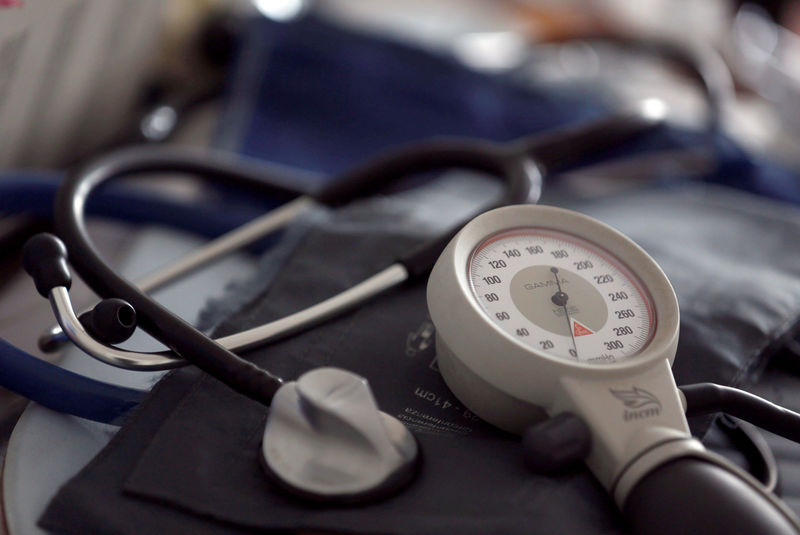By Mark Miller
CHICAGO (Reuters) - When Medicare prescription drug insurance was created in 2003, the idea that beneficiaries with very high drug costs should pick up 5 percent of the tab seemed reasonable - but that was well before specialty drugs were invented that carry price tags in the tens of thousands of dollars.
Today, the 5 percent coinsurance charge shouldered by Medicare Part D beneficiaries with serious illnesses does not look so reasonable. Instead, sky-high prices of specialty drugs threaten to bankrupt some enrollees - mainly because Part D does not cap the total amounts that enrollees must pay out of pocket each year.
A new report finds that Part D enrollees are exposed to thousands of dollars in out-of-pocket costs for drugs that treat cancer and other serious illnesses. Researchers at the Kaiser Family Foundation (KFF) studied expected annual out-of-pocket costs this year for 30 specialty drugs used to treat four conditions: cancer, hepatitis C, multiple sclerosis and rheumatoid arthritis. Median out-of-pocket costs ranged from $2,622 for Zepatier (for hepatitis C) to $16,551 for Idhifa (for leukemia).
But not all specialty tier drugs are covered by all Part D plans. For 14 specialty drugs examined in the study that were not covered by some or all plans this year, the median total annual costs ranged from $26,209 for Zepatier to an eye-popping $145,769 for Gleevec, a brand name drug that has revolutionized treatment of chronic myeloid leukemia and other complex disorders.
A “relatively small share of enrollees” in Part D grapple with these costs, the study notes - but that is small comfort if you are among them. The out-of-pocket costs reviewed by KFF were highest for cancer drugs, followed by hepatitis C, rheumatoid arthritis and multiple sclerosis.
Expensive patented brand-name drugs are a key part of the problem, but not the entire story. For example, there is a generic version of Gleevec - Imatinib mesylate - but KFF reports that it costs $91,844, compared with $145,787 for the brand-name version. “The generic drug may be less, but it’s still really expensive,” said Juliette Cubanski, associate director of the program on Medicare policy at KFF and a coauthor of the report.
Part D covers most outpatient prescription drugs. In 2019, the standard benefit can have a deductible as high as $415, and 25 percent coinsurance up to an initial coverage limit of $3,820 in your total out-of-pocket spending.
The next level of coverage is the so-called coverage gap, or doughnut hole. The gap was closed gradually as part of the Affordable Care Act, and it is entirely closed for brand-name drugs in 2019 - but it still features a different cost-sharing arrangement. Here, brand-name drug manufacturers must provide a 70 percent discount on drug prices, and enrollees bear 25 percent of cost out of pocket (for generic drugs, the enrollee share is 37 percent). That coverage continues until the “catastrophic” level, which begins at $5,100 in out-of-pocket spending.
Closing the coverage gap is a bit of good news, but patients using expensive specialty drugs do not really see the benefits. “They go right through the gap into the catastrophic level of coverage - maybe with the very first prescription they fill,” Cubanski said.
And the fact that Part D has no overall cap on enrollee out-of-pocket costs leaves it “out of step” with most other private coverage, she notes. For example, KFF reports that 81 percent of large employer health insurance plans had maximum dollar limits on coinsurance last year.
PROPOSED REFORMS
Part D catastrophic costs are part of the bigger debate in Washington on soaring prescription drug costs. President Donald Trump signaled in his State of the Union message this week that reform efforts targeting drug costs are a high priority, and his administration has proposed reforms that it argues would alleviate the problems in Part D. The plan calls for sharing rebates with enrollees, changing definitions of what counts toward out-of-pocket spending and capping out-of-pocket costs. That could reduce the cost of specialty drugs above the catastrophic level, but it could also mean higher costs for others with lower spending in the form of higher premiums and other out-of-pocket costs.
Democrats have urged allowing Medicare to negotiate prices directly with pharmaceutical companies. (https://reut.rs/2IzEY6E). And some Medicare for All proposals also address the issue, by covering all out-of-pocket costs, or by charging only nominal amounts for prescriptions and imposing very low annual out-of-pocket limits. “It seems that under most Medicare For All plans, the problem of high out-of-pocket drug costs would be less of an issue than it is today,” Cubanski said.
PROTECTING AGAINST RISKS
Unfortunately, there is not much that Part D enrollees can do to protect against these high out-of-pocket risks. Part D plans all charge similar amounts for specialty tier drugs, ranging from 25 to 33 percent coinsurance, so picking one plan over the other will not help much with the costs patients are required to pay. What does matter is whether the drug you need is covered by your plan.
But predicting the need for a specialty drug is impossible. “You might need one next year, but not this year,” Cubanski notes.
Low-income enrollees who qualify for Medicare’s Extra Help program, which helps pay out-of-pocket Part D costs, do get relief from high out-of-pocket costs. The program is available to enrollees with very low levels of income and assets. (https://
Extra Help offers varying levels of support, but with full help, enrollees usually pay nothing when they reach the catastrophic level of coverage.

Enrollees with somewhat higher income may qualify for assistance with specialty drug costs direct from patient assistance programs funded by pharmaceutical companies, or direct from the companies. Cubanski recommends contacting drug manufacturers directly to inquire about this, or asking your pharmacist.
(Reporting and writing by Mark Miller in Chicago; Editing by Matthew Lewis)